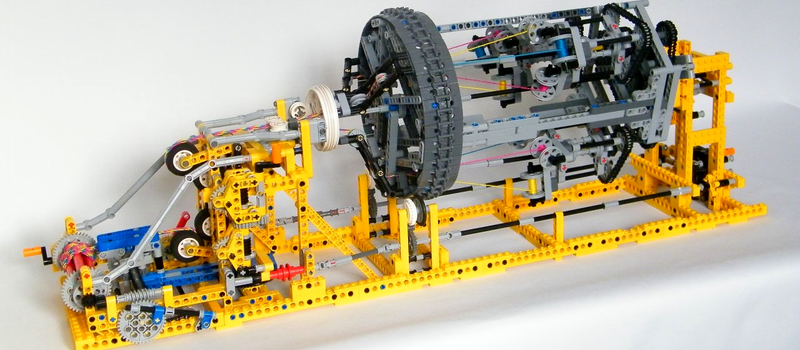If you’ve ever seen a rope-braiding machine in action, you know they’re amazing machines where bobbins of thread whirl and spin in a complex dance to weave the threads under and over each other. Building one of these machines must be incredibly difficult; building one out of LEGO Technics pieces is darn near insane.
[Nico71], as hardcore a Technics builder as they come, tackled this complex build and made it work. A large drum spins horizontally and carries three groups of three planetary-mounted thread bobbins. The entire drum spins in one direction while the bobbins and another die with three holes spin the other way. The resulting braids are then fed through another spinning die, and the resulting 9-strand rope is taken up by a winding drum. The drum has a self-reversing feeding mechanism to keep the finished spool neat and tidy. The most impressive thing about the build, though, is the fact that it’s all powered by a single motor, and that everything is synchronized via gears, shafts, sprockets, chains and clutches. It’s a Technics tour de force you can see in action after the break.
[Nico71]’s build are pretty amazing. Some are pure art, others are models of classic cars and motorcycles, but things like his loom and the calculator he’s working on now are remarkable. Of course if you need to see more of the mesmerizing ballet of rope-braiding machines, check out this 16-bobbin hand-cranked version.
Thanks for the tip, [Lizzy]
















Very cool!
I could be very wrong about this, but it looks to me like its producing twisted cord, not a braid. I cannot see any part of the machine that is actually interlacing the strands.
I was about to say the same thing… its not braiding, just twisting. If you look at his actual page with the build details you can see some closer up shots of the wire. It’s most definitely twisted. In order to braid you’d need the spindles to weave around each other on some kind of track system. It probably wouldn’t actually be impossible with legos, but way more complex. I’m kinda disappointed because thats what I was expecting to see…
I can see how it would be possible by passing a “shuttle” made of the rack pieces over two pinions close enough that it can span the gap. Then spin the whole thing around to slip the wire through the gap.
You are correct. It’s twisting, not braiding. Still very awesome!
Could this be used to produce Litz wire from individual (solid or stranded) wires?
Litz wire is braided, not twisted.
That is incorrect, nearly all litz wire is twisted because a twist gives a significantly higher packing factor than most braids, and the structural properties of a braid don’t help in litz wire (which is going to be packed into some sort of coil anyway)
The Wikipedia article uses the terms “braided”, “twisted” and “woven” interchangeably… Also, if I understand correctly the purpose of the braiding, it seems like the twisting this machine does would provide the same effect (namely, causing each wire to spend equal parts of its length in the center and at the outer surface of the cable). I think someone should test it.
The twisted wire bundle cross-section is circular, whereas the woven/braided litz wire is flat, because flat wire also helps with the proximity or “crowding” effect in the wire at high currents.
That’s several years old. At least 2 or 3 years ago i’ve seen this on youtube.
There was a model of Bugatti Veyron made of Legos with a working 7 speeds + reverse gear box.
CONGRATULATIONS!!!! You’ve just won the “I already saw it” prize! You get a gold star!
He also gets bonus points for saying legos instead of lego. More gold stars!
http://vignette3.wikia.nocookie.net/sims/images/b/bb/There_was_an_attempt.png
Thank you for your kindness. Lovely drawing. But like other brand names becoming the new name of the product (xerox instead of copier machine, adidas instead of running shoes and so on), where i live it’s ok to say legos as plural for “LEGO brick”. I deeply regret if i perturbed your inner balance.
Regarding [spceinvdr] remark: my comment wanted to spear readers time (skip watching something old) and also suggest a more interesting LEGO application. If i knew some read hackaday just for posting unuseful comments i would added a link to a DUPLO build, as being appropiate for their age.
With kind regards,
Me.